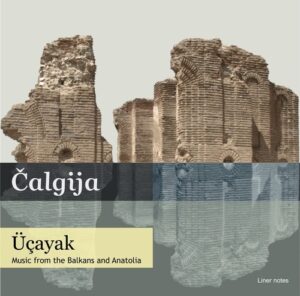
Het nieuwe album Üçayak van het ensemble Čalgija bevat nieuw oud materiaal uit de Balkan en Anatolië.
English version below
Al decennia lang doen veldwerkers er alles aan om lokale muziek veilig te stellen. Melodieën die door de globalisering verloren dreigen te gaan, op te nemen en te noteren. Alan Lomax registreerde zo honderden melodieën uit de V.S. en West Europa, Deben Battacharya deed iets soortgelijks in India. In de 19de eeuw waren het Bela Bartok en Zoltán Kodaly die de Hongaarse volksmuziek noteerden. Zij waren daarmee de eerste etnomusicologen. Kodaly, die de overigens de weergaloze Háry János Suite componeerde met volksmuziek-invloeden. In Nederland kennen we Ate Doornbosch, die stad en land afreisde om de lokale Nederlandse volksmuziek te archiveren en te presenteren in zijn radioprogramma Onder de Groene Linde. Tegenwoordig is drummer en musicus Michael Baird nog steeds als veldwerker actief in Zambia. Opnames brengt hij uit onder zijn label SWP-Records.
Sinds de jaren ’50 deed musicus, etnomusicoloog, componist en bandleider Wouter Swets (1930-2016) ook veldonderzoek. Maar hij ging op zoek naar de lokale muziek uit de Balkan en Griekenland. Hij noteerde deze en nam lokale melodieën op die hij thuis uitwerkte. Tien jaar later was hij de eerste Nederlandse radiomaker die de muziek uit de Balkan en Griekenland presenteerde aan het luisterend radio-publiek. Een publiek dat toendertijd nog nooit muziek uit die streek gehoord had. Bovendien richtte hij het ensemble Čalgija op waarmee hij opnames maakte en concerten gaf. Op het nieuwe album Üçayak vinden we twee soorten opnamen: track 1 t/m 9 werden opgenomen begin jaren ’80. Deze stukken werden indertijd niet langer als representatief beschouwd aangezien de bezetting van het ensemble Čalgija was veranderd. Dat deze muziek wél zeer de moeite waard is, is overduidelijk. De stukken zijn, qua intensiteit, nauwelijks van de originele te onderscheiden, gespeeld op o.a. accordeon, kanun, baglama, saz, ney, klarinet, viool, gadulka en ûd. Zowel vocale als instrumentale stukken worden met vuur en passie uitgevoerd, een kenmerk dat onmisbaar is binnen traditionele muziek. In het begeleidende boekje is veel informatie te vinden over de (tekst)inhoud, bezetting, locatie en maatsoorten van deze muziek. Dat geldt ook voor de live-opnamen (track 10 t/m 17 – mono) die werden gemaakt in 1978, compleet met applaus. Het album Üçayak is een aanrader voor de Balkan en Anatolische muziekliefhebber. Maar zeker ook voor de aspirant-luisteraar die genieten zal van ongepolijste versies van schitterende Oost-Europese muziek.
English version
The new album Üçayak by the ensemble Čalgija contains new played old material from the Balkans and Anatolia.
For decades, field workers have been doing everything they can to safeguard local music. Record and notate melodies that are in danger of being lost due to globalization. Alan Lomax recorded hundreds of melodies from the US. and Western Europe, Deben Battacharya did something similar in India. In the 19th century it was Bela Bartok and Zoltán Kodaly who notated Hungarian folk music. They were thus the first ethnomusicologists. Kodaly, who composed the incomparable Háry János Suite with Hunagarian folk music influences. In the Netherlands we know Ate Doornbosch, who traveled all over the country to archive local Dutch folk music and to present it in his radio program Onder de Groene Linde. Today, drummer and musician Michael Baird is still active as a field recordist in Zambia. He releases the recordings under his label SWP-Records.
Since the 1950s, musician, ethnomusicologist, composer and bandleader Wouter Swets (1930-2016) has done also field research. But he went to the Balkans and Greece for the local music. He recorded melodies that he wrote down at home. Ten years later, he was the first Dutch radio maker to present music from the Balkans and Greece to a listening radio audience. An audience that had never heard music from that region at that time. In addition, he founded the ensemble Čalgija with which he made recordings and gave concerts. The new album Üçayak contains two types of recordings: tracks 1 to 9 were recorded in the early 80s. These pieces were no longer considered representative at the time, as the line-up of the ensemble Čalgija had changed. It is obvious that this music is very worthwhile. The pieces are hardly distinguishable from the original, played on accordion, kanun, baglama, saz, ney, clarinet, violin, gadulka and ûd. Both vocal and instrumental pieces are performed with verve and passion, a characteristic indispensable in traditional music. The accompanying booklet contains a lot of (lyrics) information about the content, location, line-up and time signatures of this music. As well as for the live recordings (tracks 10 to 17 – mono) that were made in 1978, complete with applause. The CD Üçayak is a must for the Balkan and Anatolian music lover. But certainly also for the aspiring listener who will enjoy unpolished versions of beautiful Eastern European music.
- Čalgija: Üçayak (TouMilou Records / Xango)
© Mattie Poels.

Geen reacties